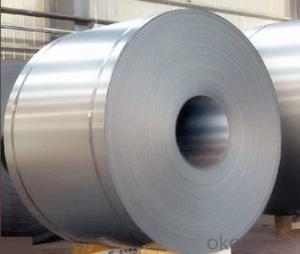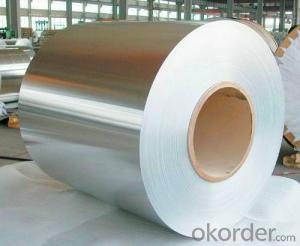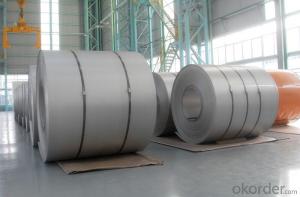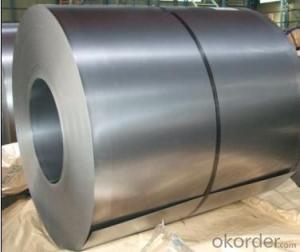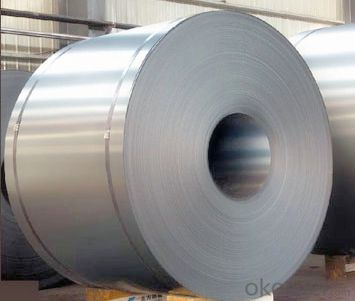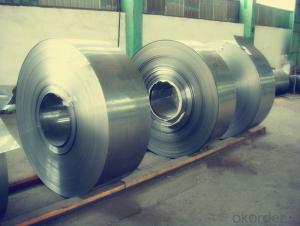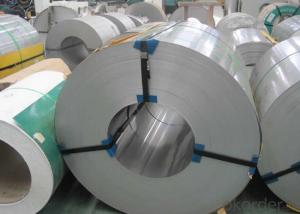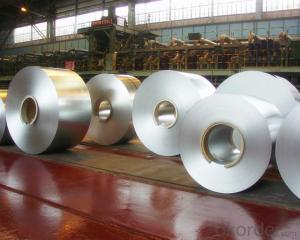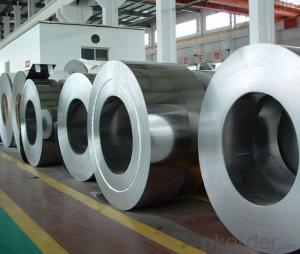Stainless Steel Coil 201 Hot / Cold Rolled
- Loading Port:
- Lianyungang
- Payment Terms:
- TT OR LC
- Min Order Qty:
- 400 m.t.
- Supply Capability:
- 5000 m.t./month
OKorder Service Pledge
OKorder Financial Service
You Might Also Like
201 Hot Rolled Stainless Steel Coil Specifications
THK:2.3/2.5/3.0/4.0mm
Width:485/510/550/610/1010/1240mm
Face:No.1
201 Hot rolled stainless steel Coil Application
Stainless steel is a production which not easy rust,acid resistance and corrosion resistance,so it is widely
used in light industry,heavy industry,daily necessities and the decoration industry.
201 hot rolled stainless steel coil, use to produce cold rolled stainless steel coil and stainless steel tube, pipe.
201 Hot Stainless Steel Coil Chemical Composition(WT%)
(C):≤0.15, (Si):≤0.75, (Mn):5.5~7.50, (Cr):16.0~18.0, (N):≤0.25, (Ni):3.50~5.50, (P):≤0.060, (S):≤0.030
201 Hot Rolled Stainless Steel Coil
Strength Of Extension:100,000 To 180,000 Psi;
Yield Strength:50,000 To 150,000 Psi
Elongation :55 To 60%;
Modulus Of Elasticity:29,000,000 Psi;
Density :.280lbs/Cubic Inch(7.93g/Cm3)
- Q: What is the hardness after heat treatment of stainless steel strips?
- The hardness of stainless steel strips after heat treatment can vary depending on several factors such as the specific grade of stainless steel, the heat treatment process used, and the desired outcome. Heat treatment of stainless steel strips is typically done to enhance certain properties such as hardness, strength, and corrosion resistance. During the heat treatment process, stainless steel strips are usually heated to a specific temperature and then cooled at a controlled rate. This allows for the transformation of the microstructure of the steel, resulting in changes to its mechanical properties. The hardness of the stainless steel strips after heat treatment is typically measured using a hardness testing method such as Rockwell or Vickers. Different heat treatment methods, such as annealing, quenching, tempering, or precipitation hardening, can be employed to achieve different hardness levels. For example, annealing is often used to soften the steel and improve its formability, resulting in lower hardness. On the other hand, quenching and tempering processes can increase the hardness of stainless steel strips by creating a martensitic structure. It is important to note that the hardness achieved through heat treatment should always be within the specified range for the particular stainless steel grade. The hardness requirements may vary depending on the intended application and the specific standards or specifications that need to be met. In conclusion, the hardness of stainless steel strips after heat treatment can range from relatively low to high, depending on the specific heat treatment process used and the desired outcome. It is crucial to follow the appropriate heat treatment procedures and adhere to the specified hardness requirements to ensure the desired properties are achieved.
- Q: What are the recommended guidelines for machining 111 stainless steel strips?
- The recommended guidelines for machining 111 stainless steel strips typically include using a sharp cutting tool, maintaining proper coolant and lubrication, controlling cutting speed and feed rate, and ensuring proper clamping and fixturing to minimize vibrations. Additionally, it is important to monitor and adjust the machining parameters based on the specific grade of the stainless steel and the desired surface finish.
- Q: Can stainless steel strips be polished to a mirror-like finish?
- Yes, stainless steel strips can be polished to a mirror-like finish. The process of achieving a mirror-like finish on stainless steel involves several steps. Initially, the surface is prepared by grinding and sanding to remove any imperfections or scratches. After that, different grades of polishing compounds are applied progressively to the surface using a buffing wheel or a polishing pad. This helps to remove the remaining scratches and create a smoother surface. Finally, a finishing compound is used to achieve a high-gloss shine, resulting in a mirror-like finish on the stainless steel strips. This process requires skill and expertise to achieve the desired result, but with the right techniques and materials, stainless steel strips can indeed be polished to a mirror-like finish.
- Q: Can stainless steel strips be used for precision instruments?
- Yes, stainless steel strips can be used for precision instruments. Stainless steel is known for its excellent strength, durability, and resistance to corrosion, making it an ideal material for precision instruments that require high accuracy and stability. Additionally, stainless steel can be easily fabricated into various shapes and sizes, allowing for customization and precise manufacturing of precision instruments.
- Q: What is the impact toughness after cryogenic treatment of stainless steel strips?
- The impact toughness of stainless steel strips is generally improved after cryogenic treatment. Cryogenic treatment involves subjecting the steel to extremely low temperatures, typically around -196°C (-321°F), to enhance its mechanical properties. This process causes a transformation of the steel's microstructure, resulting in increased hardness, strength, and resistance to wear. The impact toughness of a material refers to its ability to absorb energy and resist fracture under high-stress conditions. Cryogenic treatment helps to refine the microstructure of stainless steel, reducing the presence of brittle phases and improving its resistance to cracking or fracture when subjected to impact or high-stress situations. The low-temperature treatment also reduces residual stresses in the steel, which can further enhance its impact toughness. The reduction in residual stresses helps to improve the steel's ductility, making it less prone to sudden failure or fracture under impact or high-stress loads. Overall, the cryogenic treatment of stainless steel strips enhances their impact toughness, making them more suitable for applications that require high durability, resistance to cracking, and improved performance under impact or high-stress conditions.
- Q: Can stainless steel strips be used in medical implant manufacturing?
- Yes, stainless steel strips can be used in medical implant manufacturing. Stainless steel is a commonly used material in the medical field due to its excellent corrosion resistance, high strength, and biocompatibility. It is often used for implants such as orthopedic devices, cardiovascular stents, and dental implants.
- Q: Are stainless steel strips resistant to embrittlement?
- Yes, stainless steel strips are generally resistant to embrittlement. Embrittlement refers to the loss of ductility and the development of brittleness in a material, which can lead to cracking or fracturing under stress. Stainless steel is an alloy that contains a minimum of 10.5% chromium, which forms a protective oxide layer on the surface of the material. This oxide layer provides excellent corrosion resistance and also helps to prevent embrittlement. Additionally, stainless steel contains other alloying elements such as nickel and molybdenum, which further enhance its resistance to embrittlement. These alloying elements help to maintain the structure and integrity of the material, even under extreme conditions or exposure to high temperatures. However, it is important to note that certain factors can still lead to embrittlement in stainless steel strips. For example, exposure to very high temperatures (above the recommended operating range) or prolonged exposure to certain chemicals can cause embrittlement. Additionally, improper heat treatment or welding processes can also affect the material's resistance to embrittlement. Therefore, while stainless steel strips are generally resistant to embrittlement, it is crucial to consider the specific operating conditions and ensure proper handling, heat treatment, and maintenance to maintain the material's integrity.
- Q: What are the maximum temperatures stainless steel strips can withstand?
- The maximum temperatures that stainless steel strips can endure are dependent on the particular grade of stainless steel utilized. In general, stainless steel is recognized for its ability to resist high temperatures, making it suitable for a wide array of applications. The commonly employed grades of stainless steel, like 304 and 316, typically possess the capacity to withstand temperatures of up to approximately 1500°F (815°C) without experiencing significant deformation or loss of mechanical properties. Nonetheless, there exist specialized grades of stainless steel, for instance, 310 and 330, which exhibit an even greater resistance to high temperatures, enduring temperatures of around 2100°F (1150°C). It is vital to consider the specific grade and intended application when establishing the maximum temperature that stainless steel strips can bear.
- Q: What are the standard dimensions for stainless steel strips?
- Different applications and industry requirements can cause variations in the standard dimensions of stainless steel strips. Nevertheless, typical dimensions encompass thicknesses ranging from 0.1mm to 3.0mm, widths spanning 10mm to 600mm, and lengths extending from 1000mm to 6000mm. These dimensions find frequent usage across diverse sectors including automotive, construction, and manufacturing. It is crucial to acknowledge that customization of these dimensions can occur to suit the particular demands of a project or application.
- Q: Can stainless steel strips be used in textile machinery?
- Yes, stainless steel strips can be used in textile machinery. Stainless steel is a versatile material that offers excellent corrosion resistance, high strength, and durability. These properties make it suitable for various applications in the textile industry, including textile machinery. Stainless steel strips can be used in weaving machines, spinning machines, knitting machines, and other machinery components where strength and resistance to wear and tear are required. Additionally, stainless steel strips are easy to clean and maintain, making them ideal for use in textile machinery that comes into contact with fibers, dyes, and other chemicals.
Send your message to us
Stainless Steel Coil 201 Hot / Cold Rolled
- Loading Port:
- Lianyungang
- Payment Terms:
- TT OR LC
- Min Order Qty:
- 400 m.t.
- Supply Capability:
- 5000 m.t./month
OKorder Service Pledge
OKorder Financial Service
Similar products
Hot products
Hot Searches
Related keywords
